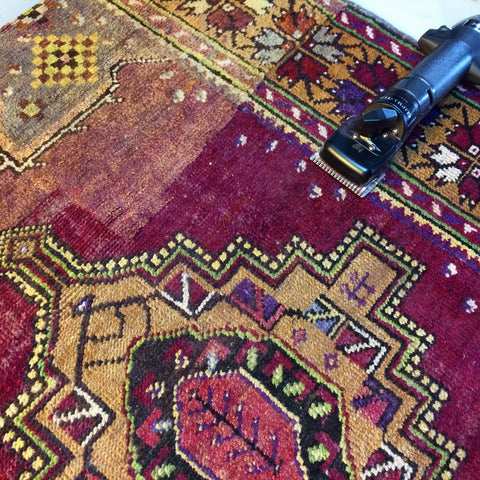Natural versus Synthetic Dyes
The first synthetic (aniline) dye was discovered by William Henry Perkin in 1856, near the end of the Industrial Revolution. Prior to that only natural dyes had been used in dying textiles including wool yarn for rug weaving. "Natural dyes have been used since the beginning of organized society, developed so humans could paint their bodies, clothes, houses, weapons and religious icons. The colors were obtained from plants, animals, fruits and earth," writes the Oaxaca Cultural Navigator, "In Mexico, [natural dye sources] include indigo, cochineal (an insect), moss, nut shells and leaves, wild flowers, tree bark, and even a sea snail that emits a deep purple ink."
Natural dyes are sourced all over the globe, each cultural center having it's own collection of regularly used materials. The colors used in older rugs are often indicators of it's origin, they can help identify when it was made, as well as who made it.
There is much debate about whether natural or synthetic dyes are better, both in rug making and in other textile industries. There are many factors to take into account when trying to answer that question: cost, environmental sustainability, human health and safety, brilliance of color, intensity of color, and color fastness. Depending on your perspective, you may come up with a different answer.
Our preference, as rug enthusiasts, is always natural dyes over synthetic. Natural dyes have a luster and glow that is often lacking in synthetic dyes. Sometimes synthetic dyes can be jarring to the eye. Natural dyes are often more harmonious and most natural dyes colors will coordinate with any other natural dye color.
With natural dyes the yarn must be first dyed yellow and then over dyed with indigo to achieve the color green.
When talking about color fastness (a material's color's resistance to fading or running), natural dyes can have a tendency to fade faster than synthetic dyes, but as they fade over time they stay true to their original color, the colors just become softer and acquire a patina. Synthetic dyes tend to be more color fast, but when they do get to the point of fading they can fade to a different or muddier color than that of the original. For example a navy blue could fade to a gray, or orange to beige. You can see in the photo below a vintage rug dyed with synthetic dyes had faded and we sheared off the top of the pile to reveal the original color below. The vibrant magenta had faded to an almost muddy orange, the lime green to a pale yellow.

There is no right or wrong when it comes to natural versus synthetic dyes, beauty is in the eye of the beholder. Some of us love those vibrant and sometimes almost electric synthetic dye colors, while others of us appreciate the results of the natural process of dying materials with plants and herbs. No matter what your choice fading is inevitable, neither natural or synthetic dyes are completely immune to the sun's rays. We recommend rotating your rugs every so often (every 6 months or so - more often if in direct sunlight) to keep the fading balanced and less noticeable. And most of all we recommend picking out a rug you love, regardless of how it's colors were obtained.

If you would like to learn more about natural or synthetic dyes please stop in and visit us at our showroom, we love to talk about all things rug, we are at 297 Forest Ave, Portland, ME 04101 Monday-Saturday 9am-5pm - Closed on Sundays.

